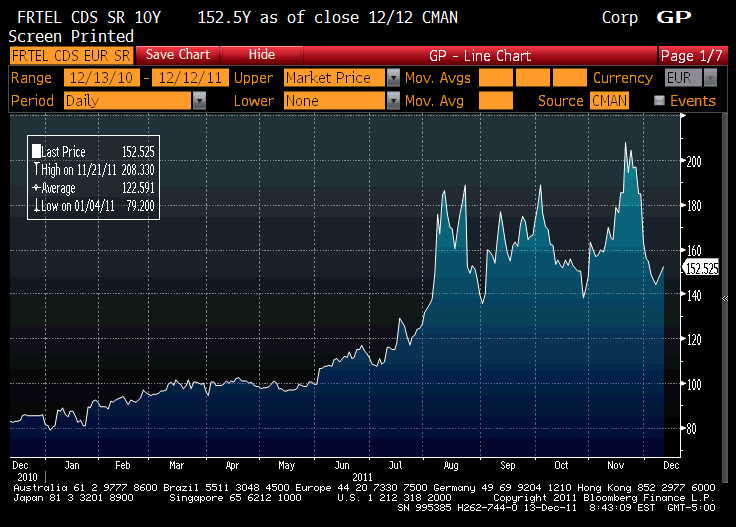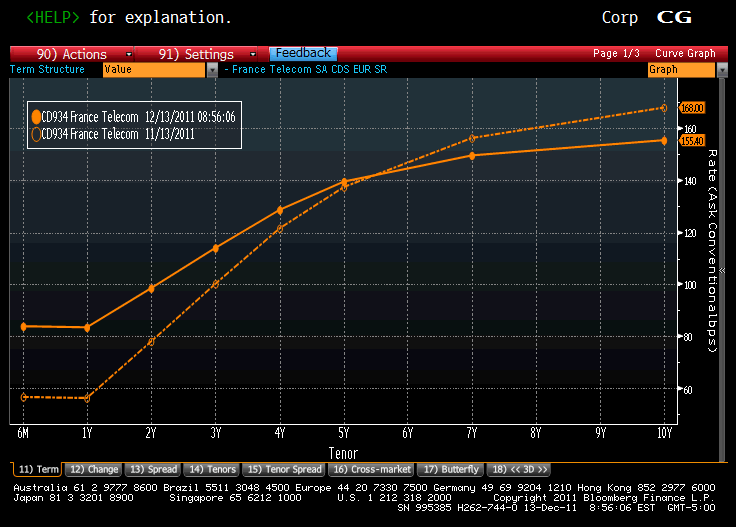France Telecom Inc (FTE)
16 Nov 2011
• The investment thesis is we buy France Telecom (FTE) for the dividend yield.
Company Overview
• Revenue Trends
Revenues - FTE’s revenue for first 9 months of 2011 was €33,848m, down 1.6% compared to comparable 2010 figures. EBITDA was €11,611m for the three quarters of 2011, down 5.4% from 2010.
Margins – FTE’s EBITDA margins were 34.3%, down 1.4 points from previous year.
Cashflows - FTE confirms their full year guidance. They expect their operating cash flow to be slightly above €9b for 2011.
• France Telecom’s Operating Segments
France

France is FTE’s largest operating region by revenue. FTE took new steps in offers segmentation implemented in France driving successful momentum share of broadband net adds. That is the reason naked ADSL customers increased 31.2%. Revenue fell 3.1%. ARPU for Personal Communication Services (Mobile Phones) fell 2.6%.

Market share for Orange is stabilizing.

Excluding regulation, ARPU grew 1.6%. With regulatory restrictions, ARPU fell 2.4%.

Churn rates have been brought down and stabilized at 14% to 15%. Strong net contract adds of 229,000 new subscribers.
Overall, the picture looks bleak. But the good thing is the metrics (Market share, churn, ARPU) have stabilized.
The remaining segments are small compared to France. The various key metrics are in the following tables:






Note that Everything Everywhere is FTE’s Joint Venture with Deutsche Telecom in the UK. FTE merged Orange UK with Deutsche’s T-Mobile. FTE owns 50% of the resulting JV.
• Capital Expenditure
CAPEX was equal to 11.0% of revenues, representing 3.731 billion euros of investment in the first nine months of 2011, a 7.5% increase on a comparable basis on the previous year. FTE confirms their guidance that CapEx will reach 13% of revenue for the full year. I estimate that to be 5,868m for the full year.
• France Telecom Debt Profile

The above table is accurate as of 30 June 2011. No table was given in 3Q 11. FTE’s debt maturity profile is quite benign for 2012, given that only 2.7b in debt is coming due. That is only 8.15% of total debt on 30 Jun 2011. Even if the new debt is refinanced at a much higher rate, the overall average interest expense will not increase significantly because the amount of debt to be refinanced is not a large part of the total.
FTE’s total debt as of 30 Jun 2011 is €33,137m and €660m in financial lease liabilities. Bonds and perpetual bonds (TDIRA) make up €29,830m of the debt. Total Gross financial liabilities is €36,902m. The difference is made up of commitments to purchase shares, derivatives and other financial liabilities.
At an average interest rate of 5.5%, FTE will have a 10% head room to meet dividend payments. At 6.6%, FTE will just be able to cover all dividend payments.
Company Positives
• Dividend yield is 11.25% at a €12.445 share price.
• Business is stabilizing – ARPU, market share and churn - are all stabilizing.
• Debt maturity profile over 2012 is benign.
• Cash flow coverage of the dividend is adequate. There is approximately 10% headroom in terms of dividend cover.
Company Negatives/Risks
• If the European Sovereign crisis were to spread to France, and FTE is not able to re-finance or has to re-finance at punitive rates, then the company will miss its dividend payout.
• FTE cuts their div. While this is unlikely in 2011, given the fluidity of the situation in Europe, this remains a possibility.
• Key drivers of a div cut is a fall in revenue, increase in operating costs or a sudden increase in capex.
• Of the 3, I believe that a fall in revenue is the most probable threat because of the bad economic situation in France. It is hard to model how bad this could get. The reason is a lot of this is driven by the macro-economic situation. So if we buy this stock, a critical signal for us to sell would be consecutive quarters of revenue/ ARPU drops.
- Consequences of a div cut would be a drastic drop in price. Again here, it depends on how bad the div cut is. If they do cut, I suspect that it will be to make the div yield fall to ~5% - 6% or Eur 0.70 (div now is Eur 1.40). The reason is the US telcos are yielding around ~5%. I'd be ok with a 5% div yield, esp if we buy the US ADR. They are unlikely to cut to 0 because the French gov is a large shareholder of the company (~25%) and the French gov needs all the cash they can get their hands on.
Conclusion & Recommendation
• I would buy the stock at ~€12.00 or alternatively buy the US ADR at around ~$16.00. There’s no need to chase the stock.




